SECRECY OR FREEDOM?
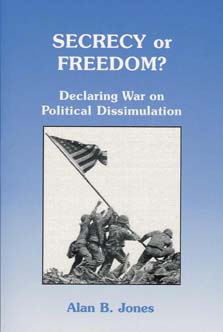 This
is our most recent book, published in April, 2001. While countless books
have been written revealing yet one more outrage which the New World Order
folks have perpetrated on us, we have resolved on an entirely different
purpose: to define a way of mounting a counterattack on those elites, and
not just delay their next victory, but destroy their viability, and take
back our country and the world for middle class citizens everywhere.
This
is our most recent book, published in April, 2001. While countless books
have been written revealing yet one more outrage which the New World Order
folks have perpetrated on us, we have resolved on an entirely different
purpose: to define a way of mounting a counterattack on those elites, and
not just delay their next victory, but destroy their viability, and take
back our country and the world for middle class citizens everywhere.
In the same way that an army or a football team will surely
lose in the long run if it has only a defense and no offense, we too shall
lose our world to the elites if we fail to marshal our resources, mount
a viable offense against them, and reduce their present dominance of public
affairs to a nullity. To that end, we have in this book gone back into
history to discover their origin, their modus operandi, their strengths,
and most importantly, their weaknesses. We have been successful, and have
found a crucial weakness which may readily be exploited. We will, in this
web page, outline our search, our major findings, and finally a plan of
action to save our country for the benefit, we hope, of a great number
of future generations of free citizens.
Our historical look will go back 2000 years and beyond.
Our sources are not generally well known, are not Nobel prize- winning
historians, but nevertheless are historical truth seekers whose researches
are uniquely valuable. Each of the chapters of Secrecy or Freedom?
carries the title of the historical work which is reviewed in that chapter.
In this web page, we will give you an inkling of what is covered in each
of these chapters, with the hope that these few words will lead you to
order our book, carefully absorb its contents, and then join in our proposed
action plan to take back our country.
.
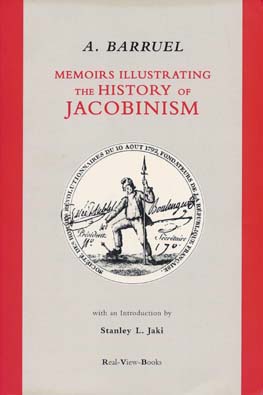 1.
Memoirs
Illustrating the History of Jacobinism, by
Abbé Augustin Barruel, 1797. Barruel lived through the years of
planning of the French Revolution. Opposing it, he barely escaped France
to England in 1792, with the Jacobin revolutionaries in hot pursuit. He
resolved to write about the three streams of effort which produced the
conflagration: the anti- Christian movement headed by such as Voltaire,
the French Masonic organization nominally headed by Philip of Orleans,
and Adam Weishaupt's Illuminati organization which came to dominate Masonry.
Each of these groups demanded utter secrecy and ruthlessness of the upper
levels of its members, along with expert and vigorous lying by those members
to protect and maintain their organizational secrecy. Barruel's book contains
an unmatched discussion of the internal organization and methodology of
the Illuminati, and lays the groundwork for a great deal of the later historical
research into the "World Revolution" which has continued to the present
day.
1.
Memoirs
Illustrating the History of Jacobinism, by
Abbé Augustin Barruel, 1797. Barruel lived through the years of
planning of the French Revolution. Opposing it, he barely escaped France
to England in 1792, with the Jacobin revolutionaries in hot pursuit. He
resolved to write about the three streams of effort which produced the
conflagration: the anti- Christian movement headed by such as Voltaire,
the French Masonic organization nominally headed by Philip of Orleans,
and Adam Weishaupt's Illuminati organization which came to dominate Masonry.
Each of these groups demanded utter secrecy and ruthlessness of the upper
levels of its members, along with expert and vigorous lying by those members
to protect and maintain their organizational secrecy. Barruel's book contains
an unmatched discussion of the internal organization and methodology of
the Illuminati, and lays the groundwork for a great deal of the later historical
research into the "World Revolution" which has continued to the present
day.
.
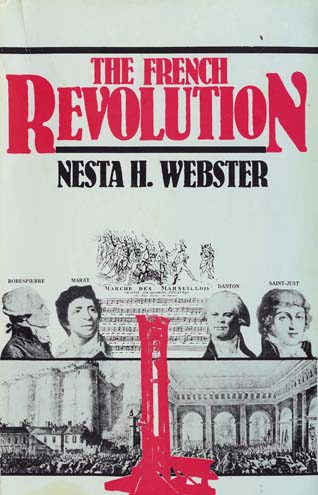 2.
The
French Revolution, by Nesta H. Webster, 1919.
In this book, Webster details the five major public events of the Revolution,
which clearly indicate, she says, the non-culpability of the French public
in either the planning or the execution of the civil destruction. The great
bulk of the French population favored the creation of a French constitution
akin to what had just been created in the United States. However, the Constitutionalists
in the 1789 French National Assembly were outvoted and soon ejected by
the Orleanist and subversive revolutionary members of the Assembly who,
as they opposed the will of the people, had obviously lied to their constituents
in order to get elected. The revolution could not have succeeded without
this duplicitous behavior of the Assembly, which not only destroyed the
people's hope for a system of stable constitutional freedoms, but actually
destroyed all French civil government of any kind, exactly as the high
level Masons and Illuminati secretly desired.
2.
The
French Revolution, by Nesta H. Webster, 1919.
In this book, Webster details the five major public events of the Revolution,
which clearly indicate, she says, the non-culpability of the French public
in either the planning or the execution of the civil destruction. The great
bulk of the French population favored the creation of a French constitution
akin to what had just been created in the United States. However, the Constitutionalists
in the 1789 French National Assembly were outvoted and soon ejected by
the Orleanist and subversive revolutionary members of the Assembly who,
as they opposed the will of the people, had obviously lied to their constituents
in order to get elected. The revolution could not have succeeded without
this duplicitous behavior of the Assembly, which not only destroyed the
people's hope for a system of stable constitutional freedoms, but actually
destroyed all French civil government of any kind, exactly as the high
level Masons and Illuminati secretly desired.
.
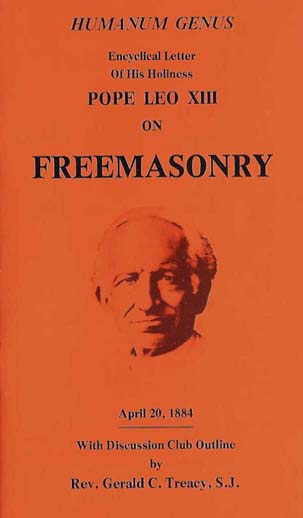 3.
Humanum
Genus - on Freemasonry, by Pope Leo XIII,
1884. In this encyclical, Leo exhorts the leaders of the Catholic Church
to "tear away the mask from Freemasonry, and let it be seen as it really
is," including its artifices, its depravity, and its wickedness. He notes
that popes from 1738 have denounced the sect, as have many secular governments.
The public, however, has remained uninformed as to the sect's secret purposes,
secret leaders, and secret actions. Members have sworn, under pain of death,
to maintain secrecy, to unquestioningly follow the orders of unseen and
unknown leaders, and to lie to the public and to lower level members as
to the sect's goals. These strategies have been very successful, such that
the goals can no longer be hidden, namely, the overthrow of the entire
religious and political order produced by Christian morality. Thus, in
1884 the Church made clear that it had been well aware for the prior 150
years that it was itself one of the primary targets for destruction by
the revolutionaries.
3.
Humanum
Genus - on Freemasonry, by Pope Leo XIII,
1884. In this encyclical, Leo exhorts the leaders of the Catholic Church
to "tear away the mask from Freemasonry, and let it be seen as it really
is," including its artifices, its depravity, and its wickedness. He notes
that popes from 1738 have denounced the sect, as have many secular governments.
The public, however, has remained uninformed as to the sect's secret purposes,
secret leaders, and secret actions. Members have sworn, under pain of death,
to maintain secrecy, to unquestioningly follow the orders of unseen and
unknown leaders, and to lie to the public and to lower level members as
to the sect's goals. These strategies have been very successful, such that
the goals can no longer be hidden, namely, the overthrow of the entire
religious and political order produced by Christian morality. Thus, in
1884 the Church made clear that it had been well aware for the prior 150
years that it was itself one of the primary targets for destruction by
the revolutionaries.
.
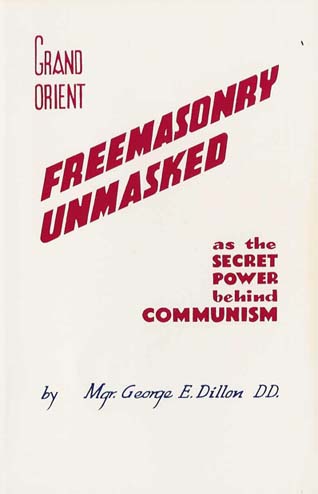 4.
Grand
Orient Freemasonry Unmasked, by Monsignor
George F. Dillon, 1885. Dillon responded to Pope Leo's call to unmask Freemasonry
by writing this little book, first published in London in 1885, then lost
to the world, then rediscovered and republished in 1950. The new publisher
noted that "...the amateur detective is now replaced by the political investigator,
[one of whom described the book as] 'the most exciting thriller
I have ever read, because the whole plot is being enacted in living pages.'"
Dillon traces the European anti-Christian movement from the 16th century
up through Voltaire, and then takes on the Freemasons, also going back
to the 16th century. By the 18th century, the Masonic core was to be found
in England, from which lodges were thrown off into Europe, including Philip
of Orleans' Grand Orient Lodge in Paris.
4.
Grand
Orient Freemasonry Unmasked, by Monsignor
George F. Dillon, 1885. Dillon responded to Pope Leo's call to unmask Freemasonry
by writing this little book, first published in London in 1885, then lost
to the world, then rediscovered and republished in 1950. The new publisher
noted that "...the amateur detective is now replaced by the political investigator,
[one of whom described the book as] 'the most exciting thriller
I have ever read, because the whole plot is being enacted in living pages.'"
Dillon traces the European anti-Christian movement from the 16th century
up through Voltaire, and then takes on the Freemasons, also going back
to the 16th century. By the 18th century, the Masonic core was to be found
in England, from which lodges were thrown off into Europe, including Philip
of Orleans' Grand Orient Lodge in Paris.
Dillon then discusses the rise of Weishaupt, the French
Revolution, Napoleon's triumphs and downfall, the successors to Weishaupt
at the head of the Illuminati, the place of Mazzini and the Carbonari,
the subversive leadership of Lord Palmerston in the mid-19th century in
orchestrating the 1848 European Revolution, the Crimean War, the rise of
Bismarck, the defeat of Austria, and finally the defeat of France in the
1870 Franco- Prussian War, exposing the Pope to the armies of the Italian
Mason Victor Emmanuel. All of the papal property in Italy was expropriated,
excepting only the Vatican enclave in which the Pope presently resides.
Remarkably, England alone remained revolution- free. Karl Marx is mentioned
for the first time. A wonderful little book!
.
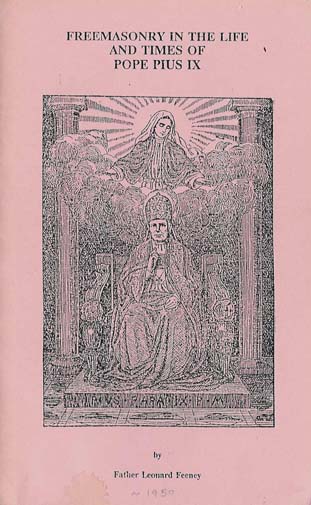 5.
Freemasonry
in the Life and Times of Pope Pius IX, by
Fr. Leonard Feeney, 1950. This short little book concentrates on the revolutionary
events personally experienced by Leo's predecessor, Pope Pius IX, Pope
from 1846 until his death at age 86 in 1878. A brave and pious man, he
was nevertheless obliged to succumb in 1870 when confronted with overwhelming
physical power, even though that power mismatch had been arranged by the
most perfidious of political machinations. Lenin would later say, truthfully,
that revolutions are made out of the barrel of a gun. The Pope's secular
power was now destroyed, as had been planned a half- century earlier and
recorded in papers to which Pius IX had been made privy by his predecessor
Pope Gregory XVI. However, Pius IX never gave up his spiritual and moral
authority, and that papal authority, though much diluted today, has not
yet been completely lost.
5.
Freemasonry
in the Life and Times of Pope Pius IX, by
Fr. Leonard Feeney, 1950. This short little book concentrates on the revolutionary
events personally experienced by Leo's predecessor, Pope Pius IX, Pope
from 1846 until his death at age 86 in 1878. A brave and pious man, he
was nevertheless obliged to succumb in 1870 when confronted with overwhelming
physical power, even though that power mismatch had been arranged by the
most perfidious of political machinations. Lenin would later say, truthfully,
that revolutions are made out of the barrel of a gun. The Pope's secular
power was now destroyed, as had been planned a half- century earlier and
recorded in papers to which Pius IX had been made privy by his predecessor
Pope Gregory XVI. However, Pius IX never gave up his spiritual and moral
authority, and that papal authority, though much diluted today, has not
yet been completely lost.
.
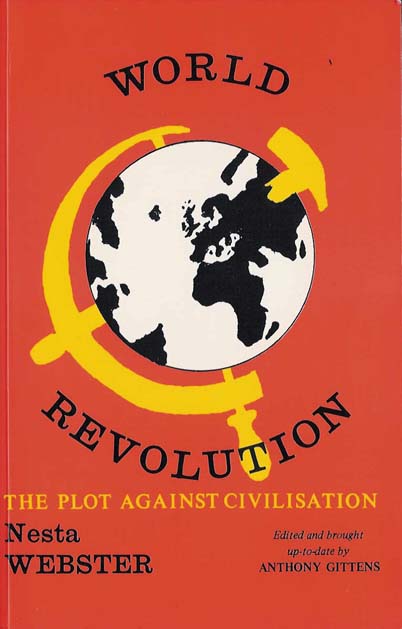 6.
World
Revolution, by Nesta H. Webster, 1921.Our
main interests in this book are (1) the corroboration which it gives to
Dillon's account of the 19th century European wars, and (2) Webster's account
of the continuity of revolutionary thought from Weishaupt to Lenin. One
of Robespierre's peers was one Francois Babeuf, who wrote a proclamation
entitled "Manifesto of the Equals," which described in minute detail how
society would work under their new order. The interesting thing is that
the Marx/Engels Communist Manifesto was essentially a plagiarization
of Babeuf's Manifesto. Further, the identical notions were proclaimed by
the Bolsheviks in Russia after 1917, as Webster quotes Lenin's lieutenant
Bucharin. From Weishaupt through Babeuf, Marx, and Lenin, the revolutionists
pushed "the five abolitions," namely of monarchy and all other ordered
government, of national patriotism, of property and inheritance, of all
religion, and of marriage and the family.
6.
World
Revolution, by Nesta H. Webster, 1921.Our
main interests in this book are (1) the corroboration which it gives to
Dillon's account of the 19th century European wars, and (2) Webster's account
of the continuity of revolutionary thought from Weishaupt to Lenin. One
of Robespierre's peers was one Francois Babeuf, who wrote a proclamation
entitled "Manifesto of the Equals," which described in minute detail how
society would work under their new order. The interesting thing is that
the Marx/Engels Communist Manifesto was essentially a plagiarization
of Babeuf's Manifesto. Further, the identical notions were proclaimed by
the Bolsheviks in Russia after 1917, as Webster quotes Lenin's lieutenant
Bucharin. From Weishaupt through Babeuf, Marx, and Lenin, the revolutionists
pushed "the five abolitions," namely of monarchy and all other ordered
government, of national patriotism, of property and inheritance, of all
religion, and of marriage and the family.
Webster spends a good deal of effort in documenting the
involvement of the Freemasons and other European secret societies with
the revolutions in mid- century, the establishment of the First International
(not a workingman's organization), the rash of worldwide
assassinations incident to the "refounding" of the Illuminati in Germany
in about 1880, and the conning of the German military into helping Lenin
cross Germany and enter Russia, whence Russia shortly thereafter became
a slave state, Germany's foremost enemy, and the bane of the 20th century.
.
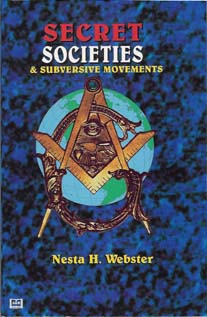 7.
Secret
Societies and Subversive Movements, by Nesta
H. Webster, 1924. Barruel, in his search for the origin of Freemasonry,
had identified its philosophical progenitor as the Manicheans, extant some
1600 years prior to the French Revolution. Webster's search backwards aimed
at studying secret societies as a broader generality. Noting their connection
to the world religions born in the Near East, she focused her study on
the secret movements which grew out of those religions. The three religions
were Judaism, Christianity, and Islam. The Essenes, Gnostics, and Manicheans
grew out of the Judaic/Christian complex, and from the Shiite branch of
Islam sprouted the much more murderous secret societies of the Batinis,
the Fatimites, and the Assassins, the latter being "the supreme model"
(Webster's words) used in structuring the later European secret societies.
7.
Secret
Societies and Subversive Movements, by Nesta
H. Webster, 1924. Barruel, in his search for the origin of Freemasonry,
had identified its philosophical progenitor as the Manicheans, extant some
1600 years prior to the French Revolution. Webster's search backwards aimed
at studying secret societies as a broader generality. Noting their connection
to the world religions born in the Near East, she focused her study on
the secret movements which grew out of those religions. The three religions
were Judaism, Christianity, and Islam. The Essenes, Gnostics, and Manicheans
grew out of the Judaic/Christian complex, and from the Shiite branch of
Islam sprouted the much more murderous secret societies of the Batinis,
the Fatimites, and the Assassins, the latter being "the supreme model"
(Webster's words) used in structuring the later European secret societies.
These European societies started with the Knights Templar
(who were exposed to infection by both the Manicheans and the Assassins
during the Crusades), and proceeded through the Freemasons, the Illuminati,
the Carbonari, the International, and the Bolsheviks up to the time of
Webster's writing. Among the many valuable things we learn from her work
is the fact that the technology of secret societies has developed in a
more or less straight line over many centuries, while several different
managing entities have used them from time to time, each responding to
man's fatal flaw that power corrupts.
.
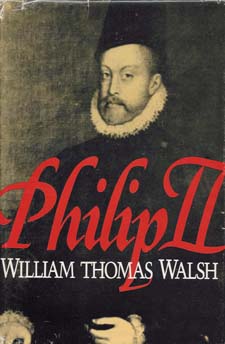 8.
Philip
II, by William Thomas Walsh, 1937. This magnificent
biography displays some of the suppressed European history from the 15th
century through the 17th, i.e., from the Renaissance to the onset of the
House of Hanover in England. It tells the story of the wars of King Philip
and of his father, King Charles I of Spain, who was also the Holy Roman
Emperor Charles V. Their struggles were directed against the Turks who
were waging a Holy War against Christian Europe, the militant Protestants
(e.g., the French Huguenots) who were waging war against the Catholic Church
and Catholic monarchies, and the Marrano Jews recently displaced from Spain
and welcomed into Antwerp and elsewhere in Europe, including London. Philip
and his father misjudged Elizabeth, and supported her to be the next Queen
of England. However, upon attaining the throne, Elizabeth surrounded herself
with Protestant advisors and proceeded to loot the English Catholic Church
of its properties, and otherwise turn England away from Catholicism.
8.
Philip
II, by William Thomas Walsh, 1937. This magnificent
biography displays some of the suppressed European history from the 15th
century through the 17th, i.e., from the Renaissance to the onset of the
House of Hanover in England. It tells the story of the wars of King Philip
and of his father, King Charles I of Spain, who was also the Holy Roman
Emperor Charles V. Their struggles were directed against the Turks who
were waging a Holy War against Christian Europe, the militant Protestants
(e.g., the French Huguenots) who were waging war against the Catholic Church
and Catholic monarchies, and the Marrano Jews recently displaced from Spain
and welcomed into Antwerp and elsewhere in Europe, including London. Philip
and his father misjudged Elizabeth, and supported her to be the next Queen
of England. However, upon attaining the throne, Elizabeth surrounded herself
with Protestant advisors and proceeded to loot the English Catholic Church
of its properties, and otherwise turn England away from Catholicism.
The wars impoverished Spain, but gave Protestant England
time to consolidate its power, and prepare for the 17th century revolutions
which would ultimately install the German Hanovers as the English rulers.
Walsh identifies a number of the prominent families (Cromwell, Cecil, Russell,
Gresham, Coligny, and William of Orange- Nassau) who were involved in the
two- century conspiracy to that end. Philip came to suspect the secret
cooperation of his several enemies, but was never able to act effectively
on those suspicions. Walsh goes to considerable lengths to identify ties
between various of the conspiring families and the secret society activity
afoot in the 16th century, such as the 1535 international Masonic meeting
in Cologne, which was also discussed by Dillon in his book (our Chapter
4).
.
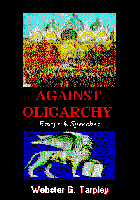 9.
Against
Oligarchy, by Webster G. Tarpley, 1970-1996.
(See Links Page for source reference.) Tarpley
found the missing thread for which so many of us have looked for so long,
and he has exposed it. Today's oligarchical elite stem from the oligarchs
who ruled Venice between approximately the 8th and the 17th centuries.
They manufactured little (except for ships), but dominated trade within
the whole Mediterranean world via both the seas and the overland route
to the Far East. Their governance consisted of a carefully maintained group
of oligarchical families who ran Venice for the benefit of the families.
The families elected the state leaders from their own group, with the general
Venetian population having nothing to say about governance. Their techniques
were arbitrary and brutal. The slave trade and piracy were state-run enterprises.
They grew exceedingly wealthy.
9.
Against
Oligarchy, by Webster G. Tarpley, 1970-1996.
(See Links Page for source reference.) Tarpley
found the missing thread for which so many of us have looked for so long,
and he has exposed it. Today's oligarchical elite stem from the oligarchs
who ruled Venice between approximately the 8th and the 17th centuries.
They manufactured little (except for ships), but dominated trade within
the whole Mediterranean world via both the seas and the overland route
to the Far East. Their governance consisted of a carefully maintained group
of oligarchical families who ran Venice for the benefit of the families.
The families elected the state leaders from their own group, with the general
Venetian population having nothing to say about governance. Their techniques
were arbitrary and brutal. The slave trade and piracy were state-run enterprises.
They grew exceedingly wealthy.
With the discovery of America and the ocean route to the
Far East just before 1500, the Venetian oligarchs saw that Venice was misplaced
to permit it to dominate the new world, so the oligarchs decided to move
their center of operations to the European Atlantic coast, first to the
Netherlands and then to England. They either created or exacerbated the
Reformation and the religious wars that accompanied it, to keep Europe
preoccupied while they consolidated their move from Venice. They engineered
Henry VIII's Anne Boleyn affair, resulting finally in the elevation of
Anne's daughter Elizabeth as Queen, and then surrounded Elizabeth with
their own agents. After the 1688 Glorious Revolution, their own form of
oligarchical governance was installed in England, where it remains to the
present day. England was conquered, and without the English even knowing
it.
They then created the Bank of England, which later served
as the model for our own Federal Reserve System. Soon came the flooding
of English Masonry throughout Europe, the creation of the Illuminati and
the French Revolution, the wars of Lord Palmerston, the care and feeding
of Karl Marx, the manipulations of King Edward VII leading to World War
1, and the conquest of Russia by the Bolsheviks. The story is absolutely
fascinating.
.
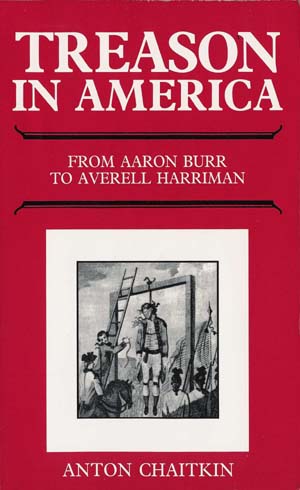 10.
Treason
in America, by Anton Chaitkin, 1985. Chaitkin's
theme is that, after the American Revolution, the English acknowledged
only the temporary, but not the permanent, loss of their American colonies,
and that they plotted for the next half- century to recover them. The treason
was led in America by the "Essex Junto," a cabal of wealthy New Englanders
who remained loyal to the mother country. (Much of their wealth had been
derived from drug running around the world, and slave trafficking into
the Americas, slave trafficking being an enterprise which the "British
Venetians" had brought with them from Venice and continued to dominate.)
Chaitkin names lots of names connected with the European oligarchs, such
as Gallatin and Astor, and many more conspirators who were purely American,
such as Aaron Burr and Presidents Pierce and Buchanan. Chaitkin, using
family histories as primary source material, details the efforts made by
the British- created Workman Plan, by the War of 1812, and most importantly
by the American Civil War.
10.
Treason
in America, by Anton Chaitkin, 1985. Chaitkin's
theme is that, after the American Revolution, the English acknowledged
only the temporary, but not the permanent, loss of their American colonies,
and that they plotted for the next half- century to recover them. The treason
was led in America by the "Essex Junto," a cabal of wealthy New Englanders
who remained loyal to the mother country. (Much of their wealth had been
derived from drug running around the world, and slave trafficking into
the Americas, slave trafficking being an enterprise which the "British
Venetians" had brought with them from Venice and continued to dominate.)
Chaitkin names lots of names connected with the European oligarchs, such
as Gallatin and Astor, and many more conspirators who were purely American,
such as Aaron Burr and Presidents Pierce and Buchanan. Chaitkin, using
family histories as primary source material, details the efforts made by
the British- created Workman Plan, by the War of 1812, and most importantly
by the American Civil War.
The British instigated the war by creating and funding
the abolitionist movement in the North led by William Lloyd Garrison, while
simultaneously creating and funding the slavery- supporting Scottish Rite
Freemasonry movement, led by Caleb Cushing, which expanded into the South
to recruit what would become the Confederate Army. Both Garrison and Cushing
were creatures of the Essex Junto. The British were determined by this
war to split the Union, engage European forces via Mexico and Canada, retake
their southern plantation economy, and prevent the North from growing enough
to ever be able to challenge Britain. Lincoln ultimately prevailed, however,
recognizing the British effort for what it really was, and building Northern
industrial strength sufficient to raise men and arms enough to win the
war. Chaitkin's account fills in many more additional and important details
of this pitifully unknown and misunderstood period in our history.
.
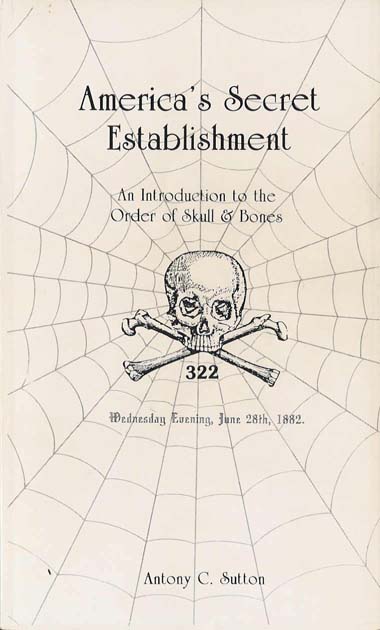 11.
America's
Secret Establishment, by Antony Sutton, 1986.
Sutton shows that conspiratorial efforts via secret societies are still
alive and very well in today's United States of America. Well- known as
an historical researcher, a set of documents was surreptitiously sent to
him in 1982 listing the membership of an American secret society called
The Order, established at Yale University in 1833 as a chapter of a German
secret society. He was appalled at the prominence and importance of the
listed members, and thereupon wrote this present book, his magnum
opus. Members were listed who were dominant in public education,
the philanthropic foundations, religion, major law firms, publishing, major
industry, finance, and politics.
11.
America's
Secret Establishment, by Antony Sutton, 1986.
Sutton shows that conspiratorial efforts via secret societies are still
alive and very well in today's United States of America. Well- known as
an historical researcher, a set of documents was surreptitiously sent to
him in 1982 listing the membership of an American secret society called
The Order, established at Yale University in 1833 as a chapter of a German
secret society. He was appalled at the prominence and importance of the
listed members, and thereupon wrote this present book, his magnum
opus. Members were listed who were dominant in public education,
the philanthropic foundations, religion, major law firms, publishing, major
industry, finance, and politics.
As a sampling, a few of the names were Henry Sloan Coffin,
Henry Stimson, Henry Luce, William Buckley, Pierre Jay (the first chairman
of the N.Y. Federal Reserve Bank), Averell Harriman, and various Tafts,
Bushes (both George and George W.), Chafees, Lovetts, Bundys, and lots
more. If any member is questioned about The Order, he is instructed to
not answer and to leave the presence of the questioner. Sutton said that
dozens of questions that had bothered him about how the world really worked
suddenly had obvious answers. His findings lend great relevance to the
action plan which we will propose in our next chapter.
.
 12.
Let's
Fix America!, by Alan B. Jones, 1994. In this
chapter we present our action plan, and its rationale, for neutralizing
the oligarchy's power sufficiently to obtain a Congress which will seek
to pursue our society's legitimate constitutional goals. We follow that
with a list of such goals, and the needed actions, mostly legislative,
to attain them. It should surprise no one that the list of actions is substantially
that originally published in Let's Fix America!, but modified
by certain alterations and additions which, by the year 2001, we have found
to be necessary or desirable, and which we have here spelled out in some
detail.
12.
Let's
Fix America!, by Alan B. Jones, 1994. In this
chapter we present our action plan, and its rationale, for neutralizing
the oligarchy's power sufficiently to obtain a Congress which will seek
to pursue our society's legitimate constitutional goals. We follow that
with a list of such goals, and the needed actions, mostly legislative,
to attain them. It should surprise no one that the list of actions is substantially
that originally published in Let's Fix America!, but modified
by certain alterations and additions which, by the year 2001, we have found
to be necessary or desirable, and which we have here spelled out in some
detail.
The Oligarchy's weakness which we intend to exploit is
its continuing need to lie, and to lie convincingly, in order to get elected
and to stay elected. If polygraphs can be used to help seek out spies in
our FBI and in our nuclear weapons labs, how much more important
is it to assure that our policy- making legislators are also honestly
in the service of the public, and honestly honoring their oaths of office
to support the Constitution and the freedoms of our citizenry which the
Constitution was specifically designed to try to protect. We propose, very
briefly, to provide for voluntary, privately administered polygraph tests
to be given to candidates running in primary elections for state and federal
legislative offices. A candidate who passes may then report to the
public that he has been found to be truthful in claiming to support and
defend the Constitution, as his oath requires. Much more detail is provided
in our chapter.
.
Link to Home Page, LFA
Page, HTW Page, SOF
Page, RPH Page, RAF
Page, Ordering
Page, or Links Page.
* * *
 This
is our most recent book, published in April, 2001. While countless books
have been written revealing yet one more outrage which the New World Order
folks have perpetrated on us, we have resolved on an entirely different
purpose: to define a way of mounting a counterattack on those elites, and
not just delay their next victory, but destroy their viability, and take
back our country and the world for middle class citizens everywhere.
This
is our most recent book, published in April, 2001. While countless books
have been written revealing yet one more outrage which the New World Order
folks have perpetrated on us, we have resolved on an entirely different
purpose: to define a way of mounting a counterattack on those elites, and
not just delay their next victory, but destroy their viability, and take
back our country and the world for middle class citizens everywhere.
 1.
Memoirs
Illustrating the History of Jacobinism, by
Abbé Augustin Barruel, 1797. Barruel lived through the years of
planning of the French Revolution. Opposing it, he barely escaped France
to England in 1792, with the Jacobin revolutionaries in hot pursuit. He
resolved to write about the three streams of effort which produced the
conflagration: the anti- Christian movement headed by such as Voltaire,
the French Masonic organization nominally headed by Philip of Orleans,
and Adam Weishaupt's Illuminati organization which came to dominate Masonry.
Each of these groups demanded utter secrecy and ruthlessness of the upper
levels of its members, along with expert and vigorous lying by those members
to protect and maintain their organizational secrecy. Barruel's book contains
an unmatched discussion of the internal organization and methodology of
the Illuminati, and lays the groundwork for a great deal of the later historical
research into the "World Revolution" which has continued to the present
day.
1.
Memoirs
Illustrating the History of Jacobinism, by
Abbé Augustin Barruel, 1797. Barruel lived through the years of
planning of the French Revolution. Opposing it, he barely escaped France
to England in 1792, with the Jacobin revolutionaries in hot pursuit. He
resolved to write about the three streams of effort which produced the
conflagration: the anti- Christian movement headed by such as Voltaire,
the French Masonic organization nominally headed by Philip of Orleans,
and Adam Weishaupt's Illuminati organization which came to dominate Masonry.
Each of these groups demanded utter secrecy and ruthlessness of the upper
levels of its members, along with expert and vigorous lying by those members
to protect and maintain their organizational secrecy. Barruel's book contains
an unmatched discussion of the internal organization and methodology of
the Illuminati, and lays the groundwork for a great deal of the later historical
research into the "World Revolution" which has continued to the present
day.
 2.
The
French Revolution, by Nesta H. Webster, 1919.
In this book, Webster details the five major public events of the Revolution,
which clearly indicate, she says, the non-culpability of the French public
in either the planning or the execution of the civil destruction. The great
bulk of the French population favored the creation of a French constitution
akin to what had just been created in the United States. However, the Constitutionalists
in the 1789 French National Assembly were outvoted and soon ejected by
the Orleanist and subversive revolutionary members of the Assembly who,
as they opposed the will of the people, had obviously lied to their constituents
in order to get elected. The revolution could not have succeeded without
this duplicitous behavior of the Assembly, which not only destroyed the
people's hope for a system of stable constitutional freedoms, but actually
destroyed all French civil government of any kind, exactly as the high
level Masons and Illuminati secretly desired.
2.
The
French Revolution, by Nesta H. Webster, 1919.
In this book, Webster details the five major public events of the Revolution,
which clearly indicate, she says, the non-culpability of the French public
in either the planning or the execution of the civil destruction. The great
bulk of the French population favored the creation of a French constitution
akin to what had just been created in the United States. However, the Constitutionalists
in the 1789 French National Assembly were outvoted and soon ejected by
the Orleanist and subversive revolutionary members of the Assembly who,
as they opposed the will of the people, had obviously lied to their constituents
in order to get elected. The revolution could not have succeeded without
this duplicitous behavior of the Assembly, which not only destroyed the
people's hope for a system of stable constitutional freedoms, but actually
destroyed all French civil government of any kind, exactly as the high
level Masons and Illuminati secretly desired.
 3.
Humanum
Genus - on Freemasonry, by Pope Leo XIII,
1884. In this encyclical, Leo exhorts the leaders of the Catholic Church
to "tear away the mask from Freemasonry, and let it be seen as it really
is," including its artifices, its depravity, and its wickedness. He notes
that popes from 1738 have denounced the sect, as have many secular governments.
The public, however, has remained uninformed as to the sect's secret purposes,
secret leaders, and secret actions. Members have sworn, under pain of death,
to maintain secrecy, to unquestioningly follow the orders of unseen and
unknown leaders, and to lie to the public and to lower level members as
to the sect's goals. These strategies have been very successful, such that
the goals can no longer be hidden, namely, the overthrow of the entire
religious and political order produced by Christian morality. Thus, in
1884 the Church made clear that it had been well aware for the prior 150
years that it was itself one of the primary targets for destruction by
the revolutionaries.
3.
Humanum
Genus - on Freemasonry, by Pope Leo XIII,
1884. In this encyclical, Leo exhorts the leaders of the Catholic Church
to "tear away the mask from Freemasonry, and let it be seen as it really
is," including its artifices, its depravity, and its wickedness. He notes
that popes from 1738 have denounced the sect, as have many secular governments.
The public, however, has remained uninformed as to the sect's secret purposes,
secret leaders, and secret actions. Members have sworn, under pain of death,
to maintain secrecy, to unquestioningly follow the orders of unseen and
unknown leaders, and to lie to the public and to lower level members as
to the sect's goals. These strategies have been very successful, such that
the goals can no longer be hidden, namely, the overthrow of the entire
religious and political order produced by Christian morality. Thus, in
1884 the Church made clear that it had been well aware for the prior 150
years that it was itself one of the primary targets for destruction by
the revolutionaries.
 4.
Grand
Orient Freemasonry Unmasked, by Monsignor
George F. Dillon, 1885. Dillon responded to Pope Leo's call to unmask Freemasonry
by writing this little book, first published in London in 1885, then lost
to the world, then rediscovered and republished in 1950. The new publisher
noted that "...the amateur detective is now replaced by the political investigator,
[one of whom described the book as] 'the most exciting thriller
I have ever read, because the whole plot is being enacted in living pages.'"
Dillon traces the European anti-Christian movement from the 16th century
up through Voltaire, and then takes on the Freemasons, also going back
to the 16th century. By the 18th century, the Masonic core was to be found
in England, from which lodges were thrown off into Europe, including Philip
of Orleans' Grand Orient Lodge in Paris.
4.
Grand
Orient Freemasonry Unmasked, by Monsignor
George F. Dillon, 1885. Dillon responded to Pope Leo's call to unmask Freemasonry
by writing this little book, first published in London in 1885, then lost
to the world, then rediscovered and republished in 1950. The new publisher
noted that "...the amateur detective is now replaced by the political investigator,
[one of whom described the book as] 'the most exciting thriller
I have ever read, because the whole plot is being enacted in living pages.'"
Dillon traces the European anti-Christian movement from the 16th century
up through Voltaire, and then takes on the Freemasons, also going back
to the 16th century. By the 18th century, the Masonic core was to be found
in England, from which lodges were thrown off into Europe, including Philip
of Orleans' Grand Orient Lodge in Paris.
 5.
Freemasonry
in the Life and Times of Pope Pius IX, by
Fr. Leonard Feeney, 1950. This short little book concentrates on the revolutionary
events personally experienced by Leo's predecessor, Pope Pius IX, Pope
from 1846 until his death at age 86 in 1878. A brave and pious man, he
was nevertheless obliged to succumb in 1870 when confronted with overwhelming
physical power, even though that power mismatch had been arranged by the
most perfidious of political machinations. Lenin would later say, truthfully,
that revolutions are made out of the barrel of a gun. The Pope's secular
power was now destroyed, as had been planned a half- century earlier and
recorded in papers to which Pius IX had been made privy by his predecessor
Pope Gregory XVI. However, Pius IX never gave up his spiritual and moral
authority, and that papal authority, though much diluted today, has not
yet been completely lost.
5.
Freemasonry
in the Life and Times of Pope Pius IX, by
Fr. Leonard Feeney, 1950. This short little book concentrates on the revolutionary
events personally experienced by Leo's predecessor, Pope Pius IX, Pope
from 1846 until his death at age 86 in 1878. A brave and pious man, he
was nevertheless obliged to succumb in 1870 when confronted with overwhelming
physical power, even though that power mismatch had been arranged by the
most perfidious of political machinations. Lenin would later say, truthfully,
that revolutions are made out of the barrel of a gun. The Pope's secular
power was now destroyed, as had been planned a half- century earlier and
recorded in papers to which Pius IX had been made privy by his predecessor
Pope Gregory XVI. However, Pius IX never gave up his spiritual and moral
authority, and that papal authority, though much diluted today, has not
yet been completely lost.
 6.
World
Revolution, by Nesta H. Webster, 1921.Our
main interests in this book are (1) the corroboration which it gives to
Dillon's account of the 19th century European wars, and (2) Webster's account
of the continuity of revolutionary thought from Weishaupt to Lenin. One
of Robespierre's peers was one Francois Babeuf, who wrote a proclamation
entitled "Manifesto of the Equals," which described in minute detail how
society would work under their new order. The interesting thing is that
the Marx/Engels Communist Manifesto was essentially a plagiarization
of Babeuf's Manifesto. Further, the identical notions were proclaimed by
the Bolsheviks in Russia after 1917, as Webster quotes Lenin's lieutenant
Bucharin. From Weishaupt through Babeuf, Marx, and Lenin, the revolutionists
pushed "the five abolitions," namely of monarchy and all other ordered
government, of national patriotism, of property and inheritance, of all
religion, and of marriage and the family.
6.
World
Revolution, by Nesta H. Webster, 1921.Our
main interests in this book are (1) the corroboration which it gives to
Dillon's account of the 19th century European wars, and (2) Webster's account
of the continuity of revolutionary thought from Weishaupt to Lenin. One
of Robespierre's peers was one Francois Babeuf, who wrote a proclamation
entitled "Manifesto of the Equals," which described in minute detail how
society would work under their new order. The interesting thing is that
the Marx/Engels Communist Manifesto was essentially a plagiarization
of Babeuf's Manifesto. Further, the identical notions were proclaimed by
the Bolsheviks in Russia after 1917, as Webster quotes Lenin's lieutenant
Bucharin. From Weishaupt through Babeuf, Marx, and Lenin, the revolutionists
pushed "the five abolitions," namely of monarchy and all other ordered
government, of national patriotism, of property and inheritance, of all
religion, and of marriage and the family.
 7.
Secret
Societies and Subversive Movements, by Nesta
H. Webster, 1924. Barruel, in his search for the origin of Freemasonry,
had identified its philosophical progenitor as the Manicheans, extant some
1600 years prior to the French Revolution. Webster's search backwards aimed
at studying secret societies as a broader generality. Noting their connection
to the world religions born in the Near East, she focused her study on
the secret movements which grew out of those religions. The three religions
were Judaism, Christianity, and Islam. The Essenes, Gnostics, and Manicheans
grew out of the Judaic/Christian complex, and from the Shiite branch of
Islam sprouted the much more murderous secret societies of the Batinis,
the Fatimites, and the Assassins, the latter being "the supreme model"
(Webster's words) used in structuring the later European secret societies.
7.
Secret
Societies and Subversive Movements, by Nesta
H. Webster, 1924. Barruel, in his search for the origin of Freemasonry,
had identified its philosophical progenitor as the Manicheans, extant some
1600 years prior to the French Revolution. Webster's search backwards aimed
at studying secret societies as a broader generality. Noting their connection
to the world religions born in the Near East, she focused her study on
the secret movements which grew out of those religions. The three religions
were Judaism, Christianity, and Islam. The Essenes, Gnostics, and Manicheans
grew out of the Judaic/Christian complex, and from the Shiite branch of
Islam sprouted the much more murderous secret societies of the Batinis,
the Fatimites, and the Assassins, the latter being "the supreme model"
(Webster's words) used in structuring the later European secret societies.
 8.
Philip
II, by William Thomas Walsh, 1937. This magnificent
biography displays some of the suppressed European history from the 15th
century through the 17th, i.e., from the Renaissance to the onset of the
House of Hanover in England. It tells the story of the wars of King Philip
and of his father, King Charles I of Spain, who was also the Holy Roman
Emperor Charles V. Their struggles were directed against the Turks who
were waging a Holy War against Christian Europe, the militant Protestants
(e.g., the French Huguenots) who were waging war against the Catholic Church
and Catholic monarchies, and the Marrano Jews recently displaced from Spain
and welcomed into Antwerp and elsewhere in Europe, including London. Philip
and his father misjudged Elizabeth, and supported her to be the next Queen
of England. However, upon attaining the throne, Elizabeth surrounded herself
with Protestant advisors and proceeded to loot the English Catholic Church
of its properties, and otherwise turn England away from Catholicism.
8.
Philip
II, by William Thomas Walsh, 1937. This magnificent
biography displays some of the suppressed European history from the 15th
century through the 17th, i.e., from the Renaissance to the onset of the
House of Hanover in England. It tells the story of the wars of King Philip
and of his father, King Charles I of Spain, who was also the Holy Roman
Emperor Charles V. Their struggles were directed against the Turks who
were waging a Holy War against Christian Europe, the militant Protestants
(e.g., the French Huguenots) who were waging war against the Catholic Church
and Catholic monarchies, and the Marrano Jews recently displaced from Spain
and welcomed into Antwerp and elsewhere in Europe, including London. Philip
and his father misjudged Elizabeth, and supported her to be the next Queen
of England. However, upon attaining the throne, Elizabeth surrounded herself
with Protestant advisors and proceeded to loot the English Catholic Church
of its properties, and otherwise turn England away from Catholicism.
 9.
Against
Oligarchy, by Webster G. Tarpley, 1970-1996.
(See
9.
Against
Oligarchy, by Webster G. Tarpley, 1970-1996.
(See  10.
Treason
in America, by Anton Chaitkin, 1985. Chaitkin's
theme is that, after the American Revolution, the English acknowledged
only the temporary, but not the permanent, loss of their American colonies,
and that they plotted for the next half- century to recover them. The treason
was led in America by the "Essex Junto," a cabal of wealthy New Englanders
who remained loyal to the mother country. (Much of their wealth had been
derived from drug running around the world, and slave trafficking into
the Americas, slave trafficking being an enterprise which the "British
Venetians" had brought with them from Venice and continued to dominate.)
Chaitkin names lots of names connected with the European oligarchs, such
as Gallatin and Astor, and many more conspirators who were purely American,
such as Aaron Burr and Presidents Pierce and Buchanan. Chaitkin, using
family histories as primary source material, details the efforts made by
the British- created Workman Plan, by the War of 1812, and most importantly
by the American Civil War.
10.
Treason
in America, by Anton Chaitkin, 1985. Chaitkin's
theme is that, after the American Revolution, the English acknowledged
only the temporary, but not the permanent, loss of their American colonies,
and that they plotted for the next half- century to recover them. The treason
was led in America by the "Essex Junto," a cabal of wealthy New Englanders
who remained loyal to the mother country. (Much of their wealth had been
derived from drug running around the world, and slave trafficking into
the Americas, slave trafficking being an enterprise which the "British
Venetians" had brought with them from Venice and continued to dominate.)
Chaitkin names lots of names connected with the European oligarchs, such
as Gallatin and Astor, and many more conspirators who were purely American,
such as Aaron Burr and Presidents Pierce and Buchanan. Chaitkin, using
family histories as primary source material, details the efforts made by
the British- created Workman Plan, by the War of 1812, and most importantly
by the American Civil War.
 11.
America's
Secret Establishment, by Antony Sutton, 1986.
Sutton shows that conspiratorial efforts via secret societies are still
alive and very well in today's United States of America. Well- known as
an historical researcher, a set of documents was surreptitiously sent to
him in 1982 listing the membership of an American secret society called
The Order, established at Yale University in 1833 as a chapter of a German
secret society. He was appalled at the prominence and importance of the
listed members, and thereupon wrote this present book, his magnum
opus. Members were listed who were dominant in public education,
the philanthropic foundations, religion, major law firms, publishing, major
industry, finance, and politics.
11.
America's
Secret Establishment, by Antony Sutton, 1986.
Sutton shows that conspiratorial efforts via secret societies are still
alive and very well in today's United States of America. Well- known as
an historical researcher, a set of documents was surreptitiously sent to
him in 1982 listing the membership of an American secret society called
The Order, established at Yale University in 1833 as a chapter of a German
secret society. He was appalled at the prominence and importance of the
listed members, and thereupon wrote this present book, his magnum
opus. Members were listed who were dominant in public education,
the philanthropic foundations, religion, major law firms, publishing, major
industry, finance, and politics.
 12.
Let's
Fix America!, by Alan B. Jones, 1994. In this
chapter we present our action plan, and its rationale, for neutralizing
the oligarchy's power sufficiently to obtain a Congress which will seek
to pursue our society's legitimate constitutional goals. We follow that
with a list of such goals, and the needed actions, mostly legislative,
to attain them. It should surprise no one that the list of actions is substantially
that originally published in Let's Fix America!, but modified
by certain alterations and additions which, by the year 2001, we have found
to be necessary or desirable, and which we have here spelled out in some
detail.
12.
Let's
Fix America!, by Alan B. Jones, 1994. In this
chapter we present our action plan, and its rationale, for neutralizing
the oligarchy's power sufficiently to obtain a Congress which will seek
to pursue our society's legitimate constitutional goals. We follow that
with a list of such goals, and the needed actions, mostly legislative,
to attain them. It should surprise no one that the list of actions is substantially
that originally published in Let's Fix America!, but modified
by certain alterations and additions which, by the year 2001, we have found
to be necessary or desirable, and which we have here spelled out in some
detail.